Russell's viper
| Russell's viper | |
|---|---|
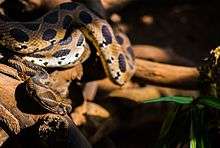 | |
| A Russell's viper at the Rajiv Gandhi Zoological Park, Pune, India | |
| Scientific classification | |
| Kingdom: | Animalia |
| Phylum: | Chordata |
| Subphylum: | Vertebrata |
| Class: | Reptilia |
| Order: | Squamata |
| Suborder: | Serpentes |
| Family: | Viperidae |
| Subfamily: | Viperinae |
| Genus: | Daboia Gray, 1842 |
| Species: | D. russelii |
| Binomial name | |
| Daboia russelii (Shaw & Nodder, 1797) | |
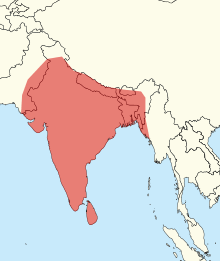 | |
| Daboia russelli distribution | |
| Synonyms | |
| |
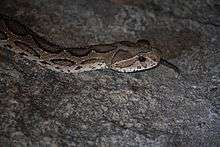
Daboia is a monotypic genus[2] of venomous Old World vipers. The single species, D. russelii, is found in Asia throughout the Indian subcontinent, much of Southeast Asia, southern China and Taiwan, and Pakistan.[1] The species was named in honor of Patrick Russell (1726–1805),[3] a Scottish herpetologist who first described many of India's snakes, and the name of the genus is from the Hindi word meaning "that lies hid", or "the lurker".[4] Apart from being a member of the big four snakes in India, Daboia is also one of the genera responsible for causing the most snakebite incidents and deaths among all venomous snakes on account of many factors, such as their wide distribution, generally aggressive demeanor, and frequent occurrence in highly populated areas.[5]
Daboia russelli is commonly known as Russell's viper and chain viper, among other names.[6][7]
Description
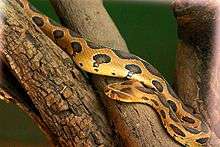
This snake can grow to a maximum total length (body + tail) of 166 cm (5.5 ft) and averages about 120 cm (4 ft) on mainland Asian populations, although island populations may be slightly smaller on average.[6] It is more slenderly built than most other vipers.[8] Ditmars (1937) reported the following dimensions for a "fair-sized adult specimen":[9]
| Total length | 4 ft., 1 inch | 124 cm |
| Length of tail | 7 inches | 18 cm |
| Girth | 6 inches | 15 cm |
| Width of head | 2 inches | 5 cm |
| Length of head | 2 inches | 5 cm |
The head is flattened, triangular, and distinct from the neck. The snout is blunt, rounded, and raised. The nostrils are large, each in the middle of a large, single nasal scale. The lower edge of the nasal touches the nasorostral. The supranasal has a strong crescent shape and separates the nasal from the nasorostral anteriorly. The rostral is as broad as it is high.[6]
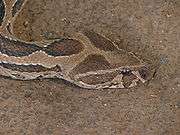
The crown of the head is covered with irregular, strongly fragmented scales. The supraocular scales are narrow, single, and separated by six to nine scales across the head. The eyes are large, flecked with yellow or gold, and surrounded by 10–15 circumorbital scales. The snake has 10–12 supralabials, the fourth and fifth of which are significantly larger. The eye is separated from the supralabials by three or four rows of suboculars. Of the two pairs of chin shields, the front pair is notably enlarged. The two maxillary bones support at least two and at the most five or six pairs of fangs at a time: the first are active and the rest replacements.[6] The fangs attain a length of 16.5 mm (0.65 in) in the average specimen.[10]
The body is stout, the cross-section of which is rounded to circular. The dorsal scales are strongly keeled; only the lowest row is smooth. Mid-body, the dorsal scales number 27–33. The ventral scales number 153–180. The anal plate is not divided. The tail is short — about 14% of the total length — with the paired subcaudals numbering 41–68.[6]
Dorsally, the color pattern consists of a deep yellow, tan, or brown ground color, with three series of dark brown spots that run the length of the body. Each of these spots has a black ring around it, the outer border of which is intensified with a rim of white or yellow. The dorsal spots, which usually number 23–30, may grow together, while the side spots may break apart. The head has a pair of distinct dark patches, one on each temple, together with a pinkish, salmon, or brownish V or X marking that forms an apex towards the snout. Behind the eye is a dark streak, outlined in white, pink, or buff. The venter is white, whitish, yellowish, or pinkish, often with an irregular scattering of dark spots.[6]
Common names
In English, common names of D. russelli include Russell's viper,[6][11][12] chain viper,[7][12] Indian Russell's viper,[13][14] common Russell's viper,[15] seven pacer,[16] chain snake, and scissors snake.[17] Previously, another common name was used to describe a subspecies that is now part of the synonymy of this form: Sri Lankan Russell's viper for D. r. pulchella.[15]
In the Indian Subcontinent, it is known as daboia (दबौया) in Hindi, Punjabi, and Urdu;[10][18] bora (বোড়া), chandra bora (চন্দ্রবোড়া), or uloo bora (উলূবোড়া) in Bengali;[10] chitalo or khadchitalo in Gujarati;[10] kolakumandala or mandaladha haavu (ಮಂಡಲದ ಹಾವು) in Kannada;[10][19] gunas on Kashmiri;[10] raktamandali, chenathandan, vattakoora, rakta anali, or thavitta (അണലി) in Malayalam;[10] ghonas (घोणस, घोण्या), tawarya in Marathi;[10] chandan boda(ଚନ୍ଦନ ବୋଡା) in Odia; koraile in Sindhi;[10] thith polonga (තිත් පොලඟා) in Sinhala;[9][10] retha aunali or kannadi viriyan (கண்ணாடி விரியன்) in Tamil;[10][20] కాటుక రేకుల పాము (katuka rekula paamu)[10] or రక్తపింజర (raktha penjara/penjari) in Telugu; and pili kandhodi in Tulu.
In Indochina, it is known as ngu maew sao in Thai[21] and mwe lewe in Burmese.[10]
Geographic range
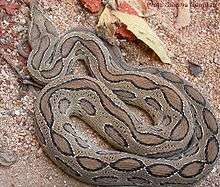

D. russelii is found in India, Pakistan, Sri Lanka, Bangladesh, Nepal, Myanmar, Thailand, Cambodia, China (Guangxi, Guangdong), Taiwan and Indonesia (Endeh, Flores, east Java, Komodo, and Lomblen Islands). The type locality is listed as "India". More specifically, this would be the Coromandel Coast, by inference of Russell (1796).[1]
Brown (1973) mentions that it can also found in Vietnam, Laos, and on the Indonesian island of Sumatra.[16] Ditmars (1937) reportedly received a specimen from Sumatra, as well.[9] However, the distribution of this species in the Indonesian archipelago is still being elucidated.[22]
Within its range, it can be very common in some areas, but scarce in others.[8] In India, is abundant in Punjab, very common along the West Coast and its hills, in southern India and north to Bengal. It is uncommon to rare in the Ganges valley, northern Bengal, and Assam. It is prevalent in Myanmar.[10] It is also common in Thailand in Pattaya and other tourist towns where its main prey, rats, have abundant food.
Habitat
It is not restricted to any particular habitat, but does tend to avoid dense forests. The snake is mostly found in open, grassy or bushy areas, but may also be found in second growth forests (scrub jungles), on forested plantations and farmland. It is most common in plains, coastal lowlands, and hills of suitable habitat. Generally, it is not found at altitude, but has been reported as far up as 2300–3000 m (7,500-9,800 ft). Humid environments, such as marshes, swamps, and rain forests, are avoided.[6]
This species is often found in highly urbanized areas and settlements in the countryside, the attraction being the rodents commensal with man.[10] As a result, those working outside in these areas are most at risk of being bitten. D. russelii does not associate as closely with human habitation as Naja and Bungarus species (cobras and kraits).[6]
Behavior
This snake is terrestrial and active primarily as a nocturnal forager. However, during cool weather, it alters its behavior and becomes more active during the day.[6]
Adults are reported to be slow and sluggish unless pushed beyond a certain limit, after which they can become very aggressive. Juveniles, though, are generally more nervous.[6]
When threatened, they form a series of S-loops, raise the first third of the body, and produce a hiss that is supposedly louder than that of any other snake. When striking from this position, they can exert so much force that even a large individual can lift most of its body off the ground in the process.[6] These snakes are strong and may react violently to being picked up.[5] The bite may be a snap, or they may hang on for many seconds.[10]
Although this genus does not have the heat-sensitive pit organs common to the Crotalinae, it is one of a number of viperines that are apparently able to react to thermal cues, further supporting the notion that they, too, possess a heat-sensitive organ.[23][24] The identity of this sensor is not certain, but the nerve endings in the supranasal sac of these snakes resemble those found in other heat-sensitive organs.[25]
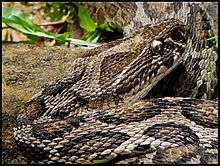
Reproduction
This species is ovoviparous.[8] Mating generally occurs early in the year, although gravid females may be found at any time. The gestation period is more than six months. Young are produced from May to November, but mostly in June and July. It is a prolific breeder. Litters of 20–40 are common,[6] although fewer offspring may occur, as few as one.[10] The reported maximum is 75[26] in a single litter. At birth, juveniles are 215–260 mm (8.5–10.2 in) in total length. The minimum total length for a gravid female is about 100 cm (39 in). It seems that sexual maturity is achieved in 2–3 years. In one case, it took a specimen nearly 4.5 hours to give birth to 11 young.[6]
Prey

It feeds primarily on rodents, especially murid species. However, it will eat just about anything; including rats, mice, shrews, squirrels, lizards, land crabs, scorpions, and other arthropods. Juveniles are crepuscular, feeding on lizards and foraging actively. As they grow and become adults, they begin to specialize in rodents. Indeed, the presence of rodents and lizards is the main reason they are attracted to human habitation.[6]
Juveniles are known to be cannibalistic.[10]
Mimicry
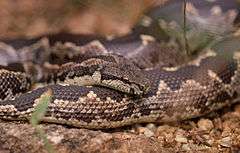
Some herpetologists believe, because D. russelii is so successful as a species and has such a fearful reputation within its natural environment, another snake has even come to mimic its appearance. Superficially, the rough-scaled sand boa, Gongylophis conicus, has a color pattern that often looks like that of D. russelii, though it is completely harmless.[6][9]
Venom
The quantity of venom produced by individual specimens is considerable. Reported venom yields for adult specimens range from 130–250 mg to 150–250 mg to 21–268 mg. For 13 juveniles with an average total length of 79 cm (31 in), the average venom yield was 8–79 mg (mean 45 mg).[6]
The LD50 in mice, which is used as a possible indicator of snake venom toxicity, is: 0.133 mg/kg intravenous,[27] 0.40 mg/kg intraperitoneal,[28] about 0.75 mg/kg subcutaneous.[29] For most humans, a lethal dose is about 40–70 mg. In general, the toxicity depends on a combination of five different venom fractions, each of which is less toxic when tested separately. Venom toxicity and bite symptoms in humans vary within different populations and over time.[6]
Envenomation symptoms begin with pain at the site of the bite, immediately followed by swelling of the affected extremity. Bleeding is a common symptom, especially from the gums and in the urine, and sputum may show signs of blood within 20 minutes after the bite. The blood pressure drops, and the heart rate falls. Blistering occurs at the site of the bite, developing along the affected limb in severe cases. Necrosis is usually superficial and limited to the muscles near the bite, but may be severe in extreme cases. Vomiting and facial swelling occur in about one-third of all cases.[6] Kidney failure (renal failure) also occurs in approximately 25-30 percent of untreated bites. Severe disseminated intravascular coagulation also can occur in severe envenomations. Early medical treatment and early access to antivenom can prevent and drastically reduce the chance of developing the severe/potentially lethal complications.
Severe pain may last for 2–4 weeks. Locally, it may persist depending on the level of tissue damage. Often, local swelling peaks within 48–72 hours, involving both the affected limb and the trunk. If swelling up to the trunk occurs within 1–2 hours, massive envenomation is likely. Discoloration may occur throughout the swollen area as red blood cells and plasma leak into muscle tissue.[17] Death from septicaemia or kidney, respiratory, or cardiac failure may occur 1 to 14 days after the bite or even later.[10]
A study in The Lancetl showed that out of a sample of people bitten by D. russelii who survived, 29% of them suffered severe damage to their pituitary glands, which later resulted in hypopituitarism.[30] Other scientific studies support the hypothesis that D. russelii bites can cause hypopituitarism.[31][32][33]
Because this venom is so effective at inducing thrombosis, it has been incorporated into an in vitro diagnostic test for blood clotting that is widely used in hospital laboratories. This test is often referred to as dilute Russell's viper venom time (dRVVT). The coagulant in the venom directly activates factor X, which turns prothrombin into thrombin in the presence of factor V and phospholipid. The venom is diluted to give a clotting time of 23 to 27 seconds and the phospholipid is reduced to make the test extremely sensitive to phospholipid. The dRVVT test is more sensitive than the aPTT test for the detection of lupus anticoagulant (an autoimmune disorder), because it is not influenced by deficiencies in clotting factors VIII, IX or XI.[34]
In India, the Haffkine Institute prepares a polyvalent antivenin that is used to treat bites from this species.[10] As of november 2016, a new antivenom was developed by the Costa Rican Clodomiro Picado Institute, and clinical trial phase in Sri Lanka.[35]
Subspecies
| Subspecies[1] | Taxon author[1] | Common name | Geographic range[6] |
|---|---|---|---|
| D. r. russelii | (Shaw, 1797) | Indian Russell's viper[36] | Across the Indian subcontinent through Pakistan and Bangladesh to Sri Lanka. |
| D. r. siamensis | (M.A. Smith, 1917) | Eastern Russell's viper (Sometimes treated as a species)[37] | From Myanmar through Thailand, Cambodia, Indonesia and southern China. Also found in Taiwan.[1] |
Taxonomy
Using morphological and mitochondrial DNA data, Thorpe et al. (2007)[38] provided evidence that the eastern subspecies should be considered a separate species, Daboia siamensis
A number of other subspecies may be encountered in literature,[6] including:
- D. s. formosensis (Maki, 1931) – found in Taiwan (considered a synonym of D. siamensis).
- D. s. limitis (Mertens, 1927) – found in Indonesia (considered a synonym of D. siamensis).
- D. r. pulchella Gray, 1842 – found in Sri Lanka (considered a synonym of D. r. russelii).
- D. r. nordicus (Deraniyagala, 1945) – found in northern India (considered a synonym of D. r. russelii).
The correct spelling of the species, D. russelii, has been, and still is, a matter of debate. Shaw & Nodder (1797), in their account of the species Coluber russelii, named it after Dr. Patrick Russell, but apparently misspelled his name, using only one "L" instead of two. Russell (1727–1805) was the author of An Account of Indian Serpents (1796) and A Continuation of an Account of Indian Serpents (1801). McDiarmid et al. (1999) are among those who favor the original misspelling, citing Article 32c (ii) of the International Code of Zoological Nomenclature. Others, such as Zhao and Adler (1993) favor russellii.[1]
In the future, more species may be added to Daboia. Obst (1983) reviewed the genus and suggested that it be extended to include Macrovipera lebetina, Vipera palaestinae, and V. xanthina. Groombridge (1980, 1986) united V. palaestinae and Daboia as a clade based on a number of shared apomorphies, including snout shape and head color pattern. Lenk et al. (2001)[39] found support for this idea based on molecular evidence, suggesting that Daboia not only include V. palaestinae, but also M. mauritanica and M. deserti.[6]
See also
- List of viperine species and subspecies
- Viperinae by common name
- Viperinae by taxonomic synonyms
- Snakebite
References
- 1 2 3 4 5 6 7 McDiarmid RW, Campbell JA, Touré TA. 1999. Snake Species of the World: A Taxonomic and Geographic Reference, Volume 1. Washington, District of Columbia: Herpetologists' League. 511 pp. ISBN 1-893777-00-6 (series). ISBN 1-893777-01-4 (volume).
- ↑ "Daboia". Integrated Taxonomic Information System. Retrieved 31 July 2006.
- ↑ Beolens, Bo; Watkins, Michael; Grayson, Michael (2011). The Eponym Dictionary of Reptiles. Baltimore: Johns Hopkins University Press. xiii + 296 pp. ISBN 978-1-4214-0135-5. (Daboia russelii, pp. 229-230).
- ↑ Weiner ESC, Simpson JA, Editors. 1991. The Compact Oxford English Dictionary: New Edition. USA: Oxford University Press. ISBN 0-19-861258-3.
- 1 2 Whitaker Z. 1989. Snakeman: The Story of a Naturalist. Bombay: India Magazine Books. 184 pp. ASIN B0007BR65Y.
- 1 2 3 4 5 6 7 8 9 10 11 12 13 14 15 16 17 18 19 20 21 22 Mallow D, Ludwig D, Nilson G. 2003. True Vipers: Natural History and Toxinology of Old World Vipers. Malabar, Florida: Krieger Publishing Company. 359 pp. ISBN 0-89464-877-2.
- 1 2 Snakes of Thailand: Venomous snakes at Siam-Info. Retrieved 20 October 2006.
- 1 2 3 Stidworthy J. 1974. Snakes of the World. Revised EDition. New York: Grosset & Dunlap Inc. 160 pp. ISBN 0-448-11856-4.
- 1 2 3 4 Ditmars RL. 1937. Reptiles of the World: The Crocodilians, Lizards, Snakes, Turtles and Tortoises of the Eastern and Western Hemispheres. New York: The McMillan Company. 321 pp.
- 1 2 3 4 5 6 7 8 9 10 11 12 13 14 15 16 17 18 19 20 Daniels JC. 2002. Book of Indian Reptiles and Amphibians. USA: Oxford University Press. 252 pp. ISBN 0-19-566099-4. (Russell's viper, pp. 148–151).
- ↑ Daboia russelii at the Reptarium.cz Reptile Database. Accessed 2 August 2007.
- 1 2 Russell's or chain viper at Wildlife of Pakistan. Retrieved 20 October 2006.
- ↑ Captive Care of the Russell's viper at VenomousReptiles.org. Retrieved 14 March 2007. Archived April 9, 2008, at the Wayback Machine.
- ↑ Somaweera A. 2007. Checklist of the Snakes of Sri Lanka. Peradeniya, Sri Lanka: Department of Zoology, Faculty of Science, University of Peradeniya. PDF at Sri Lanka Reptile. Retrieved 14 March 2007.
- 1 2 Mehrtens JM. 1987. Living Snakes of the World in Color. New York: Sterling Publishers. 480 pp. ISBN 0-8069-6460-X.
- 1 2 Brown JH. 1973. Toxicology and Pharmacology of Venoms from Poisonous Snakes. Springfield, Illinois: Charles C. Thomas. 184 pp. LCCCN 73-229. ISBN 0-398-02808-7.
- 1 2 U.S. Navy. 1991. Poisonous Snakes of the World. US Govt. New York: Dover Publications Inc. 203 pp. ISBN 0-486-26629-X.
- ↑ Daboia at MSN Encarta. Accessed 26 September 2006. Archived 2009-10-31. Archived September 27, 2006, at the Wayback Machine.
- ↑ Murthy TSN. 1990. Illustrated Guide to the Snakes of the Western Ghats, India. Calcutta: Zoological Survey of India. 76 pp. ASIN B0006F2P5C.
- ↑ Sri Lanka Wildlife Conservation Society – Checklists of the Snakes of Sri Lanka. Retrieved 2 August 2007. Archived October 8, 2007, at the Wayback Machine.
- ↑ http://thailex.asia/THAILEX/THAILEXENG/LEXICON/s.htm#Siamese Russell's Viper
- ↑ Belt P, Warrell DA, Malhotra A, Wüster W, Thorpe RS. 1997. Russell's viper in Indonesia: snakebite and systematics. In R.S. Thorpe, W. Wüster & A. Malhotra (Eds.), Venomous Snakes: Ecology, Evolution and Snakebite. Clarendon Press, Oxford. Symposia of the Zoological Society of London, No. 70: 219–234.
- ↑ Krochmal AR, Bakken GS (August 2003). "Thermoregulation is the pits: use of thermal radiation for retreat site selection by rattlesnakes". J. Exp. Biol. 206 (Pt 15): 2539–45. doi:10.1242/jeb.00471. PMID 12819261.
- ↑ Krochmal AR, Bakken GS, LaDuc TJ (2004). "Heat in evolution's kitchen: evolutionary perspectives on the functions and origin of the facial pit of pitvipers (Viperidae: Crotalinae)". J. Exp. Biol. 207 (Pt 24): 4231–8. doi:10.1242/jeb.01278. PMID 15531644.
- ↑ York DS, Silver TM, Smith AA (1998). "Innervation of the supranasal sac of the puff adder". Anat. Rec. 251 (2): 221–5. doi:10.1002/(SICI)1097-0185(199806)251:2<221::AID-AR10>3.0.CO;2-Q. PMID 9624452.
- ↑ Russell’s Viper delivers 75 snakelets - Bangalore Mirror
- ↑
- ↑
- ↑
- ↑ Thornhill, Ted (24 January 2012). "The snake bite that can reverse the effects of puberty (if you manage to survive it)". Daily Mail. London.
- ↑ Tunpe (1987). "Acute and Chronic Pituitary Failure Resembling Sheehan's Syndrome Following Bites by Russell's Viper in Burma". The Lancet. 330 (8562): 763–767. doi:10.1016/S0140-6736(87)92500-1.
- ↑ Tun-Pe; Warrell, D. A.; Tin-Nu-Swe; Phillips, R. E.; Moore, R. A.; Myint-Lwin; Burke, C. W. (1987). "Acute and chronic pituitary failure resembling Sheehan's syndrome following bites by Russell's viper in Burma". Lancet. 2 (8562): 763–767. doi:10.1016/s0140-6736(87)92500-1. PMID 2888987.
- ↑ Antonypillai, C. N.; Wass, J. A. H.; Warrell, D. A.; Rajaratnam, H. N. (2010). "Hypopituitarism following envenoming by Russell's Vipers (Daboia siamensis and D. russelii ) resembling Sheehan's syndrome: First case report from Sri Lanka, a review of the literature and recommendations for endocrine management". QJM. 104 (2): 97–108. doi:10.1093/qjmed/hcq214. PMID 21115460.
- ↑ Antiphospholipid Syndrome at SpecialtyLaboratories. Retrieved 27 September 2006.
- ↑ Rodrigo, M. Trials to start for home-grown anti-venom. Available at: http://www.sundaytimes.lk/161009/news/trials-to-start-for-home-grown-anti-venom-211742.html
- ↑ Checklist of Indian Snakes with English Common Names at University of Texas. Retrieved 22 October 2006.
- ↑ Daboia russelii siamensis at Munich AntiVenom INdex (MAVIN). Retrieved 23 October 2006.
- ↑ Thorpe RS, Pook CE, Malhotra A (2007). "Phylogeography of the Russell's viper (Daboia russelii) complex in relation to variation in the colour pattern and symptoms of envenoming". Herpetological Journal. 17: 209–18.
- ↑ Lenk P, Kalyabina S, Wink M, Joger U (April 2001). "Evolutionary relationships among the true vipers (Reptilia: Viperidae) inferred from mitochondrial DNA sequences". Molecular Phylogenetics and Evolution. 19 (1): 94–104. doi:10.1006/mpev.2001.0912. PMID 11286494.
Further reading
- Hawgood BJ (November 1994). "The life and viper of Dr Patrick Russell MD FRS (1727–1805): physician and naturalist". Toxicon. 32 (11): 1295–304. doi:10.1016/0041-0101(94)90402-2. PMID 7886689.
- Adler K, Smith HM, Prince SH, David P, Chiszar D (2000). "Russell's viper: Daboia russelii not Daboia russellii, due to Classical Latin rules". Hamadryad. 25 (2): 83–5.
- Boulenger GA. 1890. The Fauna of British India, Including Ceylon and Burma. Reptilia and Batrachia. London: Secretary of State for India in Council. (Taylor and Francis, printers). xviii + 541 pp. ("Vipera russellii", pp. 420–421, Figure 123).
- Boulenger GA. 1896. Catalogue of the Snakes in the British Museum (Natural History). Volume III., Containing the...Viperidæ. London: Trustees of the British Museum (Natural History). (Taylor and Francis, printers). xiv + 727 pp. + Plates I.- XXV. ("Vipera russellii", pp. 490–491).
- Breidenbach CH (1990). "Thermal cues influence strikes in pitless vipers". Journal of Herpetology. Society for the Study of Reptiles and Amphibians. 24 (4): 448–50. doi:10.2307/1565074. JSTOR 1565074.
- Cox M. 1991. The Snakes of Thailand and Their Husbandry. Krieger Publishing Company, Malabar, Florida. 526 pp. ISBN 0-89464-437-8.
- Daniels, J.C. Book of Indian Reptiles and Amphibians. (2002). BNHS. Oxford University Press. Mumbai. viii+238pp.
- Das I. 2002. A Photographic Guide to Snakes and Other Reptiles of India. Sanibel Island, Florida: Ralph Curtis Books. 144 pp. ISBN 0-88359-056-5. (Russell's viper, "Daboia russelii", p. 60).
- Dimitrov GD, Kankonkar RC (February 1968). "Fractionation of Vipera russelli venom by gel filtration. I. Venom composition and relative fraction function". Toxicon. 5 (3): 213–21. doi:10.1016/0041-0101(68)90092-5. PMID 5640304.
- Dowling HG (1993). "The name of Russell's viper". Amphibia-Reptilia. 14 (3): 320. doi:10.1163/156853893X00543.
- Gharpurey K. 1962. Snakes of India and Pakistan. Bombay, India: Popular Prakishan. 79 pp.
- Groombridge B. 1980. A phyletic analysis of viperine snakes. Ph-D thesis. City of London: Polytechnic College. 250 pp.
- Groombridge B. 1986. Phyletic relationships among viperine snakes. In: Proceedings of the third European herpetological meeting; 1985 July 5–11; Charles University, Prague. pp 11–17.
- Jena I, Sarangi A. 1993. Snakes of Medical Importance and Snake-bite Treatment. New Delhi: SB Nangia, Ashish Publishing House. 293 pp.
- Lenk P, Kalyabina S, Wink M, Joger U (April 2001). "Evolutionary relationships among the true vipers (Reptilia: Viperidae) inferred from mitochondrial DNA sequences". Molecular Phylogenetics and Evolution. 19 (1): 94–104. doi:10.1006/mpev.2001.0912. PMID 11286494.
- Mahendra BC. 1984. Handbook of the snakes of India, Ceylon, Burma, Bangladesh and Pakistan. Annals of Zoology. Agra, India, 22.
- Master RW, Rao SS (July 1961). "Identification of enzymes and toxins in venoms of Indian cobra and Russell's viper after starch gel electrophoresis". J. Biol. Chem. 236: 1986–90. PMID 13767976.
- Minton SA Jr. 1974. Venom Diseases. Springfield, Illinois: CC Thomas Publishing. 386 pp.
- Morris PA. 1948. Boy's Book of Snakes: How to Recognize and Understand Them. A volume of the Humanizing Science Series, edited by Jacques Cattell. New York: Ronald Press. viii + 185 pp. (Russell's viper, "Vipera russellii", pp. 156–157, 182).
- Naulleau G, van den Brule B (1980). "Captive reproduction of Vipera russelli". Herpetological Review. Society for the Study of Amphibians and Reptiles. 11: 110–2.
- Obst FJ (1983). "Zur Kenntnis der Schlangengattung Vipera". Zoologische Abhandlungen. Staatliches Museums für Tierkunde in Dresden. 38: 229–35.
- Reid HA. 1968. Symptomatology, pathology, and treatment of land snake bite in India and southeast Asia. In: Bucherl W, Buckley E, Deulofeu V, editors. Venomous Animals and Their Venoms. Vol. 1. New York: Academic Press. pp 611–42.
- Shaw G, Nodder FP. 1797. The Naturalist's Miscellany. Volume 8. London: Nodder and Co. 65 pp.
- Shortt (1863). "A short account of the viper Daboia elegans (Vipera Russellii)". Annals and Magazine of Natural History. 11 (3): 384–5.
- Silva A de (1990). Colour Guide to the Snakes of Sri Lanka. Avon (Eng): R & A Books. ISBN 1-872688-00-4. 130 pp.
- Sitprija V, Benyajati C, Boonpucknavig V (1974). "Further observations of renal insufficiency in snakebite". Nephron. 13 (5): 396–403. doi:10.1159/000180416. PMID 4610437.
- Smith MA. 1943. The Fauna of British India, Ceylon and Burma, Including the Whole of the Indo-Chinese Sub-region. Reptilia and Amphibia, Vol. III.—Serpentes. London: Secretary of State for India. (Taylor and Francis, printers). xii + 583 pp. ("Vipera russelli", pp. 482–485).
- Thiagarajan P, Pengo V, Shapiro SS (October 1986). "The use of the dilute Russell viper venom time for the diagnosis of lupus anticoagulants". Blood. 68 (4): 869–74. PMID 3092888.
- Maung-Maung-Thwin, Khin-Mee-Mee, Mi-Mi-Kyin, Thein-Than (1988). "Kinetics of envenomation with Russell's viper (Vipera russelli) venom and of antivenom use in mice". Toxicon. 26 (4): 373–8. doi:10.1016/0041-0101(88)90005-0. PMID 3406948.
- Mg-Mg-Thwin, Thein-Than, U Hla-Pe (1985). "Relationship of administered dose to blood venom levels in mice following experimental envenomation by Russell's viper (Vipera russelli) venom". Toxicon. 23 (1): 43–52. doi:10.1016/0041-0101(85)90108-4. PMID 3922088.
- Tweedie MWF. 1983. The Snakes of Malaya. Singapore: Singapore National Printers Ltd. 105 pp. ASIN B0007B41IO.
- Vit Z (1977). "The Russell's viper". Prezgl. Zool. 21: 185–8.
- Wall F (1906). "The breeding of Russell's viper". Journal of the Bombay Natural History Society. 16: 292–312.
- Wall F. 1921. Ophidia Taprobanica or the Snakes of Ceylon. Colombo, Ceylon [Sri Lanka]: Colombo Museum. (HR Cootle, Government Printer). xxii + 581 pp. ("Vipera russelli", pp. 504–529, Figures 91-92).
- Whitaker R. 1978. Common Indian Snakes. New Delhi (India): MacMillan. 85 pp.
- Wüster W (1992). "Cobras and other herps in south-east Asia". British Herpetological Society Bulletin. 39: 19–24.
- Wüster W, Otsuka S, Malhotra A, Thorpe RS (1992). "Population Systematics of Russell's viper: A Multivariate Study". Biological Journal of the Linnean Society. 47 (1): 97–113. doi:10.1111/j.1095-8312.1992.tb00658.x.
- Zhao EM, Adler K. 1993. Herpetology of China. Society for the Study of Amphibians & Reptiles. 522 pp. ISBN 0-916984-28-1.
External links
| Wikispecies has information related to: Russell's viper |
| Wikimedia Commons has media related to Daboia russelii. |
- Daboia russelii at the Reptarium.cz Reptile Database. Accessed 5 September 2007.
- Russell's viper at Michigan Engineering. Accessed 5 September 2007.
- Russell's viper at SurvivalIQ. Accessed 5 September 2007.
- Mark O'Shea in Sri Lanka at Mark O'Shea. Accessed 5 September 2007.
- Common Poisonous Snakes in Taiwan at Formosan Fat Tire. Accessed 5 September 2007.
- Video of Daboia russelii on YouTube. Accessed 5 September 2007.
- Video of Daboia russelii feeding on YouTube. Accessed 5 September 2007.
- Toxicology